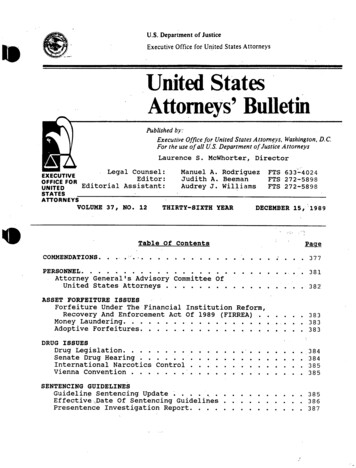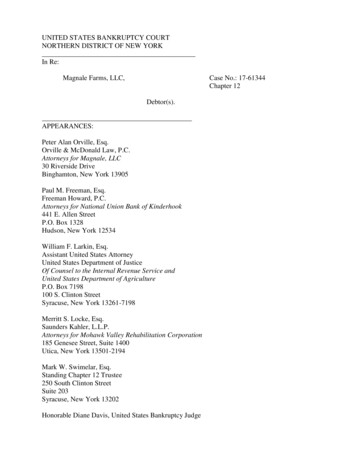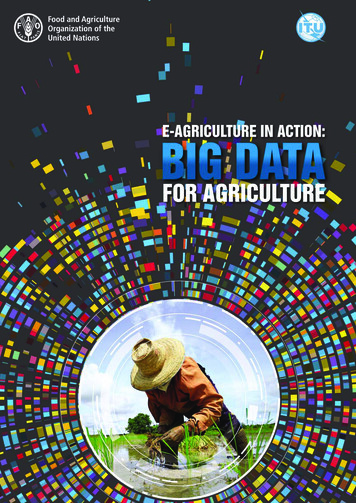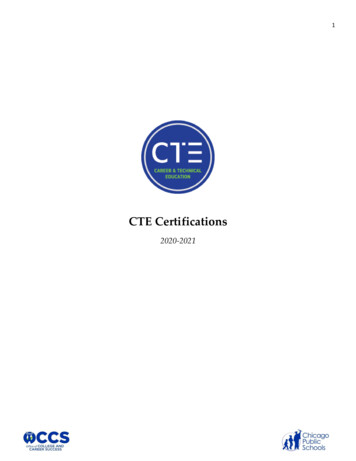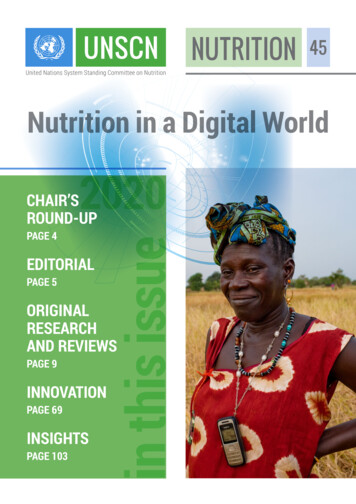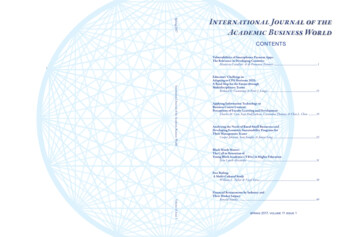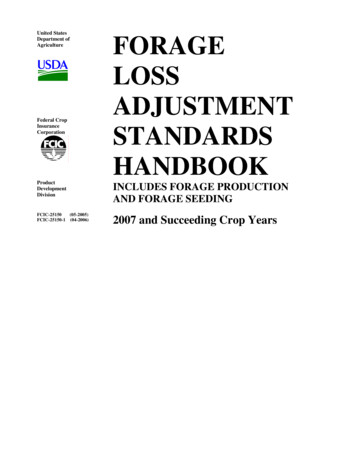
Transcription
United StatesDepartment ofAgricultureFederal FCIC-25150(05-2005)FCIC-25150-1 UDES FORAGE PRODUCTIONAND FORAGE SEEDING2007 and Succeeding Crop Years
UNITED STATES DEPARTMENT OF AGRICULTUREWASHINGTON, D.C. 20250FEDERAL CROP INSURANCE HANDBOOKSUBJECT:NUMBER: 25150 (05-2005)NUMBER: 25150-1 (04-2006)OPI: Product Development DivisionFORAGE LOSS ADJUSTMENTSTANDARDS HANDBOOK2007 AND SUCCEEDING CROPYEARSAPPROVED:DATE:/s/ Tim B. Witt04/17/2006Deputy Administrator, Research and DevelopmentTHIS HANDBOOK CONTAINS THE OFFICIAL FCIC-ISSUED LOSS ADJUSTMENTSTANDARDS FOR THIS CROP FOR THE 2007 AND SUCCEEDING CROP YEARS. ALLREINSURED COMPANIES WILL UTILIZE THESE STANDARDS FOR BOTH LOSSADJUSTMENT AND LOSS TRAINING.SUMMARY OF CHANGES/CONTROL CHARTThe following list contains significant changes to this handbook, as determined by us. It may notrepresent all changes made. All changes made to this handbook are applicable regardless of whether ornot listed.Major Changes: See changes or additions in text which have been highlighted. Three stars (***) identifyinformation that has been removed.Changes for Crop Year 2007 (FCIC-25150-1) Issued April 2006A. Pg. 4, Sec. 3 B (4): Revised language to state “For stands with less than 55 per cent of a normalstand, refer to the instructions for Section I, Item H of the Production Worksheet contained in Section10 E of this handbook.”B. Pg. 4, Sec. 3 C: Revised to comply with new prototype language regarding provisions andprocedures not applicable to CAT coverage.C. Pg. 18, Appraisal Worksheet, Item 9: Revised entry to comply with Production Worksheet.D. Pg. 30, Sec.10 E: Added instructions for “Haylage Stored in Round Silos.”E. Pg. 31, Sec. 10 F: Revised subsection from “E” to “F.”F. Pg. 40, Narrative instructions: Removed item “o,” “Document field ID’s and date and method ofdestruction of mycotoxin infested forages if it has no market value. For further documentationinstructions, refer to the LAM.” The LAM doesn’t address mycotoxin infested forages, and sinceforage has no quality/value adjustment, this statement isn’t needed. Re-lettered the remainder of theNarrative instructions accordingly.APRIL 2006SC 1FCIC-25150-1 (FORAGE)
FORAGE LOSS ADJUSTMENT STANDARDS HANDBOOKSUMMARY OF CHANGES/CONTROL CHART (Continued)G. Pg. 46, Production Worksheet, Items 4, 5, and 6: Removed Winterkill as a cause of loss from ForageProduction Worksheet.H. Pg. 47, Production worksheet, Item F: Revised “Practice” to 093.I. Pg. 48, Production worksheet, Items D, E, F, and G: Completed previously blank items.J. Pgs. 60-61, Section 11, TABLE F: Corrected previous typographical errors for 16 ft. diameter silowith a depth of 47, 48, and 49 feet, and a 28 ft. diameter silo with a depth of 91 feet.APRIL 2006SC 2FCIC-25150-1 (FORAGE)
FORAGE LOSS ADJUSTMENT STANDARDS HANDBOOKSUMMARY OF CHANGES/CONTROL CHART (Continued)CONTROL CHART FOR: FORAGE LOSS ADJUSTMENT STANDARDS 263-70APRIL 2006SC 0-1 (FORAGE)
FORAGE LOSS ADJUSTMENT STANDARDS HANDBOOKSUMMARY OF CHANGES/CONTROL CHART (Continued)THIS PAGE INTENTIONALLY LEFT BLANKAPRIL 2006SC 4FCIC-25150-1 (FORAGE)
Nurse Crop (FS)(companion crop)A crop seeded into the same acreage as another crop, thatis intended to be harvested separately, and that is planted toimprove growing conditions for the crop with which it isgrown.Spring Planted (FP) (FS) A forage crop seeded before July 1.Windrow (FP)Forage that is cut and placed in a row.Year ofEstablishment (FP)The period between seeding and when the forage productioncrop has developed an adequate stand. Insurance during theyear of establishment may be available under the forageseeding policy. Insurance under this policy does not attachuntil after the year of establishment. The year of establishmentis determined by the date of seeding. The year ofestablishment for spring planted forage is designated by thecalendar year in which seeding occurred. The year ofestablishment for fall planted forage is designated by thecalendar year after the year in which the crop was planted.3. INSURANCE CONTRACT INFORMATIONThe insurance provider is to determine that the insured has complied with all policy provisions of theinsurance contract. Crop provisions which are to be considered in this determination include (but arenot limited to):A. FORAGE PRODUCTION INSURABILITY(1)(2)The crop insured will be all the forage production in the county for which a premium rate isprovided by the actuarial documents, in which the insured has a share, and:(a)that is grown during one or more years after the year of establishment;(b)that has an adequate stand at the beginning of the insurance period;(c)that is not grown with a non-forage crop; or(d)does not exceed the age limitations for the forage stands contained in the SpecialProvisions.In addition to the causes of loss specifically excluded in the Basic Provisions, insurance isnot provided against damage of loss of production that occurs after removal from thewindrow.APRIL 20063FCIC-25150-1 (FORAGE)
B.FORAGE SEEDING INSURABILITY(1)The crop insured will be all the forage seeding in the county for which a premium rate isprovided by the actuarial documents, in which the insured has a share, and:(a)that is planted during the current crop year, or replanted during the calendar yearfollowing planting, to establish a normal stand of forage;(b)that is not grown with the intent to be grazed, or not grazed at any time during theinsurance period;(c)that is not interplanted with another crop, except nurse crops, unless allowed by theSpecial Provisions or by written agreement; and(2)IN CALIFORNIA COUNTIES: LASSEN, MODOC, MONO, SHASTA, SISKIYOUAND ALL OTHER STATES, any acreage of the insured crop damaged before the finalplanting date, to the extent that such acreage has less than 75 percent of a normal stand,must be replanted unless the insurance provider agrees that it is not practical to replant; and(3)In all other California counties, unless otherwise specified in the Special Provisions, anyacreage of the insured crop damaged anytime during the crop year to the extent that suchacreage has less than 75 percent of a normal stand must be replanted unless it cannot bereplanted and reach a normal stand within the insurance period.(4)The amount of indemnity on any spring planted acreage will be reduced 50 percent if thestand is less than 75 percent, but more than 55 percent of a normal stand. For stands withless than 55 per cent of a normal stand, refer to the instructions for Section I, Item H of theProduction Worksheet, contained in Section 10 E of this handbook.C. PROVISIONS AND PROCEDURES NOT APPLICABLE TO CATCOVERAGE***Refer to the CIH and LAM for provisions and procedures not applicable to CAT.APRIL 20064FCIC-25150-1 (FORAGE)
17.Production in Tons: Appraisal in Tons, to tenths, per acre. Compute the appraisal on aSpecial Report using the following formula:Determined plant count per square foot divided by applicable plant population per squarefoot from the Special Provisions for the specific crop year, times APH approved yield,times applicable factor for the cutting from TABLE B for the specific area. Round onlythe last computation (to tenths). Refer back to FORAGE PRODUCTION appraisalmethods, subsection 6 E, Stand Count Method.EXAMPLE: (Refer to EXHIBIT 2, Forage Production Stand Count Appraisal MethodWorksheet)Insured crop is alfalfa. Location is west of the Continental Divide.Determined plant count per square foot is 2.0 plants.Plant count (second harvest year plant population) per square foot from the SpecialProvisions for the specific harvest year, is 6.0 plants for the second harvest year.APH approved yield is 3.5 tons per acre.The potential production prior to second cutting is being appraised, 0.50 from TABLE B.(2.0 divided by 6.0, 2nd harvest year) times 3.5 times .50 equals 0.6 tons per acre. Roundonly at the last computation to tenths.18.Adjuster’s Signature, Code Number, and Date: Signature of adjuster, code number, anddate signed after the insured (or insured’s authorized representative) has signed. If theappraisal is performed prior to signature date, document the date of appraisal in theRemarks/Narrative section of the Appraisal Worksheet (if available); otherwise, documentthe appraisal date in the Narrative of the Production Worksheet.19.Insured’s Signature and Date: Insured’s (or insured’s authorized representative’s)signature and date. BEFORE obtaining insured’s signature, REVIEW ALL ENTRIES onthe appraisal worksheet WITH THE INSURED, particularly explaining codes, etc., whichmay not be readily understood.Page: Page numbers - (Example: Page 1 of 1, Page 1 of 2, Page 2 of 2, etc.).APRIL 200617FCIC-25150-1 (FORAGE)
COMPANY NAME: ANY COMPANYCLAIM NUMBER: XXXXXXXX1. INSURED’S NAMEFOR ILLUSTRATION PURPOSES ONLY2. POLICY NUMBERI. M. INSUREDAPPRAISAL WORKSHEET(Forage Seeding – Forage Production)XXXXXXXCROP TYPE CODESA ALFALFA3. UNIT NUMBER001005. FORAGE SEEDINGAM ALFALFA GRASS MIXTURESGM GRASS MIXTURESX Before second cutting789101112131415TypeCodeAcresToTenthsPlant Counts Per Sample orOunces Per SampleTotal FromAll SamplesNumberSamplesAvg. NumberPlants orOunces PerSampleNumberSquare Feetin SampleDeviceAvg. Numberof Plants orOunces PerSquare 123456789101112131415161718 11I. M. ADJUSTERXXXXX17ProductionIn Tons10912CODE NUMBER16Factor91118. SIGNATURE OF ADJUSTERYYYY6. FORAGE PRODUCTIONFieldID14. CROP YEAR101 10 MM/DD/YYYY 5 2.0X X X X X X 19. INSURED’S SIGNATUREDATE10.1 DATEI. M. INSUREDMM/DD/YYYYPage 1 ofAPRIL 2006180.61FCIC-25150-1 (FORAGE)
(c)To determine tons for small square or round bales which are piled (not stacked) andthe number of bales cannot be determined, use the following method:1Determine the size of the pile of bales and the average size of each bale: lengthtimes width times depth equals cubic feet.2Determine the average weight per bale, then divide the average weight per baleby the average number of cubic feet per bale to equal the number of pounds percubic ft.3Divide 2,000 pounds by the pounds per cubic foot to equal the number of cubicfeet per ton.4Divide the number of cubic feet in the pile by the number of cubic feet per tonto equal the number of tons in the pile.EXAMPLE:Pile is 30.0 ft. x 20.0 ft. x 10.0 ft. 6,000 cu. ft.Average bale is 1.5ft. x 1.2 ft. x 2.5 ft. 4.5 cu. ft. @ 47 lbs. per bale47 lbs. 4.5 cu. ft. 10.4 lbs. per cu. ft.2000 lbs. per ton 10.4 lbs. per cu. ft. 192 cu. ft. per ton (round to whole cubic feet)6000 cu. ft. 192 cu. ft. per ton 31.3 tons(5)Stack Wagons (chopped hay):Multiply length times width times depth, then divide by the appropriate cubic feet per tonshown in item 4a or 4b in section 11, TABLE G, to arrive at the number of tons.D. HAYLAGE IN STORAGE OTHER THAN ROUND SILOS(1)Haylage in trench silo calculations:FORMULA:(Average Width (W) x Length (L) x Depth of silage (D) cu. ft.) 50 wet tons.Convert to dry tons by multiplying the wet tons by .35 (DM Factor with 65 percentmoisture silage) 100 percent DM.Multiply 100% DM. tons times 1.15 (87 percent moisture factor) Tons @ 87 percentDM.APRIL 200629FCIC-25150-1 (FORAGE)
EXAMPLE:(20 ft. 16 ft.) 2 18 ft. Avg. Width(18 ft. (W) x 50 ft. (L) x 12ft. (D)) 10,800 cu. ft.10,800 cu. ft. 50 216.0 wet tons.216 wet tons x .35 75.6 100 percent DM.75.6 x 1.15 (87 percent moisture factor) 86.9 tons of 13 percent moisture dry hayequivalent.(2)Horizontal Plastic Tubes (60-70 percent Moisture):8 Ft. Diameter 885 pounds of 13 percent moisture haylage per linear foot.9 Ft. Diameter 1045 pounds of 13 percent moisture haylage per linear foot.10 Ft. Diameter 1205 pounds of 13 percent moisture haylage per linear foot.FORMULA: (Length (L) x pounds per linear foot) 2000 lbs. per ton tons.EXAMPLE:50 ft. (L) x 885 lbs. per ft. (8' diameter) 44,250 lbs.44,250 lbs. 2,000 lbs. per ton 22.1 tons at 13 percent moisture.E.HAYLAGE STORED IN ROUND SILOS(1) Apply the silo diameter and depth of harvested production as shown in section 11, TABLEF to determine the tons of 100 percent dry matter.(2) Multiply the result of (1) above by 1.15 to convert the dry matter to 13 percent moistureequivalent.APRIL 200630FCIC-25150-1 (FORAGE)
F.FORM ENTRIES AND COMPLETION INFORMATIONVerify or make the following entries:ItemNo.Information Required1.Crop/Code #:2.Unit #: Five-digit unit number from the Summary of Coverage after it is verified to becorrect. (e.g., 00100)3.Legal Description: Section, township, and range numbers or other legal description thatidentifies the location of the unit.4.Date of Damage: First three letters of the month during which MOST of the insureddamage (including progressive damage) occurred for each inspection. Include theSPECIFIC DATE where applicable as in the case of hail damage (e.g., AUG 11).5.Cause of Damage: Name of insured cause(s) of loss for this crop as listed in the LAM. Ifit is evident that no indemnity is due, enter “NONE.” If an insured cause of loss is coded as“Other,” explain in the Narrative. Refer to the Basic Provisions and the applicable cropprovisions for information pertaining to insured and uninsured causes of loss.6.Primary Cause %:“Forage Production”“Forage Seeding”(0033)(0032)PRELIMINARY: MAKE NO ENTRY.REPLANT AND FINAL: Percent of damage for the cause of damage listed in item 5above that is determined to be the primary cause of damage, to the nearest whole percent.The primary cause of damage must exceed 50 percent (e.g., 51%). Enter an “X” in themajor secondary cause of damage.7.Company/Agency: Name of company and agency servicing the contract.8.Name of Insured: Name of the insured that identifies EXACTLY the person (legal entity)to whom the policy is issued.9.Claim #: Claim number as assigned by the insurance provider.10.Policy #: Insured’s assigned policy number.11.Crop Year: Four-digit crop year, as defined in the policy, for which the claim has beenfiled.APRIL 200631FCIC-25150-1 (FORAGE)
12.Additional Units:PRELIMINARY AND REPLANT: MAKE NO ENTRY.FINAL: Unit number(s) for ALL non-loss units for the crop at the time of final inspection.A non-loss unit is any unit for which a Production Worksheet has not been completed.Additional non-loss units may be entered on a single Production Worksheet.If more spaces are needed for non-loss units, enter the unit numbers, identified as “NonLoss Units,” in the Narrative or on an attached Special Report.13.Est. Prod. Per Acre:PRELIMINARY AND REPLANT: MAKE NO ENTRY.FINAL:Forage Seeding - Estimated average plant population per square foot for each non-lossunit for the crop at the time of final inspection.Forage Production - Estimated yield per acre, in tons to tenths, of all non-loss units for thecrop at the time of final inspection.14.Date(s) Notice of Loss:PRELIMINARY:a.Date the notice of damage was given for the unit in item 2.b.A third preliminary inspection (if needed) requires an additional set of ProductionWorksheets. Enter the date of notice for a third preliminary inspection in the 1stspace of item 14 on the second set.c.Reserve the “Final” space on the first page of the first set of Production Worksheetsfor the date of notice for the final inspection.d.If the inspection is initiated by the insurance provider, enter “Company Insp.” insteadof the date.REPLANT AND FINAL: Transfer the last date in the 1st or 2nd space to the FINALspace if a final inspection should be made as a result of the notice. Always enter thecomplete date of notice (month, day, year) for the FINAL inspection in the FINAL spaceon the first page of the first set of Production Worksheets. For a delayed notice of loss ordelayed claim, refer to the LAM.APRIL 200632FCIC-25150-1 (FORAGE)
Q.Total:Forage Production: Column “C2” (reported acres; “C” if acreage is not under-reported)times Column “P,” in tons to tenths.Forage Seeding: Column “C2” (reported acres; “C” if acreage is not under-reported)times Column “P,” in whole to dollars.16.Total Acres:PRELIMINARY: MAKE NO ENTRY.REPLANT AND FINAL: Total Actual Acres [Column “C” (or “C1” if there are underreported acres)], to tenths.FOR ITEM 17, WHEN SEPARATE LINE ENTRIES ARE MADE FOR VARYING SHARES,STAGES, APH YIELDS, PRICE ELECTIONS, TYPES, ETC., WITHIN THE UNIT, AND TOTALSNEED TO BE KEPT SEPARATE FOR CALCULATING INDEMNITIES, MAKE NO ENTRY ANDFOLLOW THE INSURANCE PROVIDER’S INSTRUCTIONS; OTHERWISE, MAKE THEFOLLOWING ENTRIES.17.Totals:PRELIMINARY: MAKE NO ENTRY.REPLANT AND FINAL: Totals of Column “O” and Column “Q.”NARRATIVE:If more space is needed, document on a Special Report, and enter “See Special Report.” Attach theSpecial Report to the Production Worksheet.a.If no acreage is released on the unit, enter “No acreage released,” adjuster’s initials, anddate.b.If notice of damage was given and “No Inspection” is necessary, enter the unit number(s),“No Inspection,” date, and adjuster’s initials. The insured's signature is not required.c.Explain any uninsured causes, unusual, or controversial cases.d.If there is an appraisal in Section I, item M for uninsured causes due to a hail/fire exclusion,show the original hail/fire liability per acre and the hail/fire indemnity per acre.e.Document the actual appraisal date if an appraisal was performed prior to the adjuster’ssignature date on the appraisal worksheet, and the date of the appraisal is not recorded onthe appraisal worksheet.APRIL 200639FCIC-25150-1 (FORAGE)
f.State that there is “No other fire insurance” when fire damages or destroys the insuredforage crop and it is determined that the insured has no other fire insurance. Refer to theLAM.g.Explain any errors found on the Summary of Coverage.h.Explain any commingled production. Refer to the LAM.i.Explain any entry for “Production Not to Count” in Section II, item “O” and/or anyproduction not included in Section II, item I or item B - E entries (e.g., harvestedproduction from uninsured acreage that can be identified separately from the insuredacreage in the unit).j.Explain a “NO” checked in item 19.k.Attach a sketch map or aerial photograph to identify the total unit:(1)(2)(3)(4)Fall Planted Forage Seeding only: Consent is or has been given to put part of theunit to another use or to replant;Fall Planted Forage Seeding only: If acreage has been replanted to a practiceuninsurable as an original practice;If uninsured causes are present; orFor unusual or controversial cases.Indicate on the aerial photo or sketch map, the disposition of acreage destroyed or put toother use with or without consent.***l.Explain any difference between date of inspection and signature dates. For an ABSENTEEinsured, enter the date of the inspection AND the date of mailing the Production Worksheetfor signature.m.When any other adjuster or supervisor accompanied the adjuster on the inspection, enter thecode number of the other adjuster or supervisor and date of inspection.n.Explain the reason for a “No Indemnity Due” claim. “No Indemnity Due” claims are to bedistributed in accordance with the insurance provider’s instructions.o.Explain any delayed notices or delayed claims as instructed in the LAM.p.Document any authorized estimated acres shown in Section I item C as follows: “Line 3‘E’ acres authorized by insurance provider MM/DD/YYYY.”q.Document the method and calculation used to determine acres for the unit. Refer to theLAM.APRIL 200640FCIC-25150-1 (FORAGE)
r.Forage Seeding: Document the appraisal (plus appraisal for uninsured causes of loss, ifapplicable) for replanted acreage, and the calculations to show that the qualification for areplanting payment has been met. Refer to section 4.s.Forage Seeding: If any acreage to be replanted in the unit does not qualify for a replantingpayment, enter Field No., “NOT QUAL FOR RP PAYMENT,” date of inspection,adjuster’s initials, and reason not qualified.t.Specify the type of insects or disease when the insured cause of damage or loss is listed asinsects or disease. Explain why control measures did not work.u.Document the name and address of the charitable organization when gleaned acreage isapplicable. Refer to the LAM for more information on gleaning.v.Document any other pertinent information, including any data to support any factors usedto calculate the production.SECTION II - HARVESTED PRODUCTIONGENERAL INFORMATION:Forage Seeding: MAKE NO HARVESTED PRODUCTION ENTRIES IN COLUMNS“A1” THROUGH “S”.Forage Production:(1)There generally will be no harvested production entries in items “A1” through “S”for preliminary inspections.(2)Record the net tons of production in all cases. When applicable weight records arenot available, compute the net tonnage. Refer to section 10, subparagraphs B, C, D,and E for production computation formulas, factors, and instructions.(3)Do not make moisture adjustments for loose stacked hay, dry chopped hay, baled hay,pellets, and alfalfa meal.(4)Account for ALL HARVESTED PRODUCTION (for ALL ENTITIES sharing in thecrop) except production appraised BEFORE harvest and shown in Section I becausethe quantity cannot be determined later. Count the production from all cuttings, on aline basis for different types of storage.(5)Columns “B” through “E” are for structure measurements entries (Rectangular,Round, Square, etc.). If structures are a combination of shapes, break into a series ofaverage measurements, if possible. Enter “Odd Shape” or “Conical Pile” ifproduction is stored in an odd shaped structure or conical pile. Documentmeasurements on a Special Report or other worksheet used for this purpose.APRIL 200641FCIC-25150-1 (FORAGE)
(6)(7)If farm-stored production has been weighed prior to storage and acceptable weighttickets are available showing gross weights, enter “Weighed and Stored On Farm” incolumns “B” through “E.” Refer to the LAM for acceptable weight tickets.(a)Records must be maintained on a unit/type basis.(b)Dates of cutting/harvesting of forage, number of bales harvested,contemporaneous weight of bales from each cutting/harvest (weight must bebased on average of at least 2 bales per/cutting/type/unit weighted, dated andsigned by a disinterested third party.(c)If contemporaneous records will not be maintained or the production is notmeasured after being placed in a storage structure, the insured may request anappraisal or inspection/measurement service from the insurance provider orother disinterested third party (at the insured’s cost), such as FSA, prior toharvest or if all production for each cutting/harvest is still available forverification.For production sold, make entries in items “B” through “E” as follows:(a)Name and address of buyer.(b) Production reports must be substantiated by marketing records from a marketingoutlet, processor, or buyer, such as, settlement sheets, certified weight tags,broker sales summaries or load receipts. These records must indicate buyer’sname, net tons of forage produced, type, producer’s name and delivery date.(8)For production fed, make entries in items “B” through “E” as follows:Fed records must specify the number of head, type of livestock (cattle, horses,sheep, etc., with weight estimated to the nearest 100 pounds for each type) andnumber of days fed.Feeding records must be documented through a formal record system (e.g.,RMA’s Guidelines for a Production Record Management System) and generatedduring the time period production was fed to be considered acceptable andcontain the following elements:(1)(2)(3)(4)(5)(9)Date forage fed.Amount fed on that date.Number of livestock fed on that date.Type and weight of livestock fed on that date.Type and/or unit should be notated.If acceptable sales or weight tickets are not available, refer to the LAM.(10) If additional lines are necessary, the data may be entered on a continuation sheet.APRIL 200642FCIC-25150-1 (FORAGE)
FOR ITEMS 22 - 24. WHEN SEPARATE LINE ENTRIES ARE MADE FOR VARYING SHARES,STAGES, APH YIELDS, PRICE ELECTIONS, TYPES, ETC., WITHIN THE UNIT, AND TOTALSNEED TO BE KEPT SEPARATE FOR CALCULATING INDEMNITIES, MAKE NO ENTRYAND FOLLOW THE INSURANCE PROVIDER’S INSTRUCTIONS; OTHERWISE, MAKE THEFOLLOWING ENTRIES.22.Section II Total:PRELIMINARY AND REPLANT: MAKE NO ENTRY.FINAL: Total of Column “S,” to tenths.23.Section I Total:PRELIMINARY AND REPLANT: MAKE NO ENTRY.FINAL: Enter figure from Section I, Column “O” total.24.Unit Total:PRELIMINARY AND REPLANT: MAKE NO ENTRY.FINAL: Total of 22 and 23, to tenths.25.Adjuster’s Signature, Code #, and Date: Signature of adjuster, code number, and datesigned after the insured (or insured’s authorized representative) has signed. For anabsentee insured, enter adjuster’s code number ONLY. The signature and date will beentered AFTER the absentee has signed and returned the Production Worksheet.Final indemnity inspections and final replanting payment inspections should be signed onthe bottom line.26.Insured’s Signature and Date: Insured’s (or insured’s authorized representative’s)signature and date. BEFORE obtaining insured’s signature, REVIEW ALL ENTRIES onthe Production Worksheet WITH THE INSURED, particularly explaining codes, etc., thatmay not be readily understood.Final indemnity inspections and final replanting payment inspections should be signed onbottom line.27.Page:PRELIMINARY: Page numbers – “1,” “2,” etc., at the time of inspection.REPLANT AND FINAL: Page numbers - (Example: Page 1 of 1, Page 1 of 2, Page 2 of2, etc.).APRIL 200645FCIC-25150-1 (FORAGE)
PRODUCTION WORKSHEET1 Crop/Code#2 Unit #001003 Legal DescriptionSW321-32N-16e8 Name of InsuredI. M. Insured(FOR ILLUSTRATION PURPOSES ONLY)Forage Prod00339 Claim Number7 Company ANY COMPANY4 Date of DamageJUL***5 Cause of DamageDrought***6 Primary Cause %12 Additional Units10000200***13 Est. Prod Per AcreAgency11 Crop YearXXXXXXXX10 Policy NumberXXXXXXXANY AGENCYYYYY1st14 Date(s)Notice of Loss2ndFinal7-30-YYYY1-11-YYYY15 Companion Policy(s)3.0SECTION I – ACREAGE APPRAISED, PRODUCTION AND ADJUSTMENTSACTUARIALAField IDAM/DBPOTENTIAL YIELDBPrelimAcresCFinalAcresDInterest orShareE20.020.51.000A01E25.025.01.00030.0CDEM/D16 0A01002551HH2.8250.6RiskPracticeHIIntended orFinal UseJAppraisedPotentialSTAGE GUARANTEEK1K2Moisture %FactorLShell and/orQuality FactorMUninsuredCauseNAdjustedPotential2.8OTotal to Count(C x N)2.8112.017 TOTALS205.0PPer Acre136.8QTotal(C x P)574.0NARRATIVE (If more space is needed, attach a Special Report) Field D plowed without consent. Acreage determined from permanent FSA measurements. Field A and B were wheel measured. Production not to count from uninsurable acreage.SECTION IIHARVESTED PRODUCTION18 Date Harvest CompletedMM/DD/YYYY19 Is damage similar to other farms in the area?NoYesMEASUREMENTSA1A2ShareField IDBLengthofDiameterYesGROSS PRODUCTIONCDEFWidthDepthDeductionNet CubicFeet100 LARGE ROUND BALESGConversionFactorHGrossProd.(F x G)20 Assignment of Indemnity?No21 Transfer of Right To Indemnity?YesNoADJUSTMENTS TO HARVESTED PRODUCTIONIBu. TonLbs. ctor75.0M1M2Test Wt.FactorNAdjustedProductionHorIxJxK2xL2xM2OProd. NotTo Count75.0300 SMALL BALES9.09.0HAYLAGE49.649.6PProduction(N – O)I. M. AdjusterxxxxxMM/DD/YYYY2nd InspectionFinal InspectionAPRIL 20061st InspectionI. M. Insured0.6xxxxxMM/DD/YYYYFinal Inspection46SProductionTo Count(P X R)75.08.48.449.649.622 Section II Total23 Section I Total24 Unit Total133.0136.8269.8DateMM/DD/YYYY27 Page 1 of 12nd InspectionI. M. AdjusterRQualityFactor(Q1 Q2)75.0I certify the information provided above, to the best of my knowledge, to be true and complete and that it wi1l be used to determine my loss, if any, to my insured crops. I understand that this Production Worksheet andsupporting papers are subject to audit and approval by the company. I understand that this crop insurance is subsidized and reinsured by the Federal Crop Insurance Corporation, an agency of the United States. I understand thatany false or inaccurate information may result in the sanctions outlined in my policy and administrative, civil, and criminal sanctions under 18 U.S.C.§ 1006 and 1014, 7 U.S.C.§ 1506, 31 U.S.C. §§ 3729 and other federal statues25 Adjuster’s Signature and Code NumberDate26 Insured’s Signature1st InspectionQ1Q2ValueMkt. PriceI. M. InsuredMM/DD/YYYYFCIC-25150-1 (FORAGE)
PRODUCTION WORKSHEET1 Crop/Code#3 Legal DescriptionSW321-32N-16e2 Unit #001008 Name of InsuredI. M. Insured(ILLUSTRATION PURPOSES ONLY)Forage Seeding00327 Company ANY COMPANY4 Date of DamageJANJUL5 Cause of DamageWinterkilldrought6 Primary Cause %12 Additional UnitsX0020013 Est. Prod Per AcreAgencyANY AGENCY9 Claim Number11 Crop YearXXXXXXXX10 Policy NumberXXXXXXX1st14 Date(s)Notice of LossYYYY2ndFinalMM/DD/YYMM/DD/YY7015 Companion Policy(s)13SECTION I – ACREAGE APPRAISED, PRODUCTION AND ADJUSTMENTSACTUARIALPOTENTIAL YIELDField IDAM/DBDPrelimAcresFinalAcresInterest orShareE20.020.51.000D0109
Insured crop is alfalfa. Location is west of the Continental Divide. Determined plant count per square foot is 2.0 plants. Plant count (second harvest year plant population) per square foot from the Special Provisions for the specific harvest year, is 6.0 plants for the second harvest year. APH approved yield is 3.5 tons per acre.




